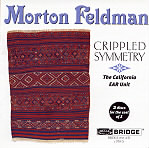Morton Feldman’s music continues to exert its fascination on listeners and record companies alike. After releasing its highly successful recording of the more than three-hour-long “For Philip Guston”, Bridge once again returns to the California EAR Unit for Crippled Symmetry, at only 87 minutes a mere bagatelle in terms of Feldman’s late output. Well, maybe not. Scored for flutes, mallet percussion, and piano/celeste, Crippled Symmetry does exactly what the title says: it toys with not quite exact repetitions of short melodic and rhythmic shapes. As each pattern exhausts itself, a new one takes its place. All of this happens at a slow tempo, at the lowest possible dynamic level. Only the composer’s own exquisite sense of sonority and timing determines how the various musical patterns are organized, and how long they persist. What makes Feldman’s music so fascinating is its complete honesty: it truly does create a series of sonic shapes moving through space, allowing the listener to literally “see” with his ears the slowly changing patterns of sound. It’s sort of like watching a mobile turn almost imperceptibly in a gentle breeze. And much as it may outrage the faithful, this is great music to fall asleep to–the perfect cure for insomnia, in fact, not because it’s dull, but because it’s so hypnotic. The EAR Unit’s performance is every bit as fine as the competing hat ART version, and lasts almost exactly as long. That performance comes with an excellent coupling in Why Patterns?, a considerable bonus, though it may be hard to find. Bridge’s sonics are exactly as they should be: transferred at a high level so that you can set the volume low, relax, and watch the music. [11/26/1999]
































